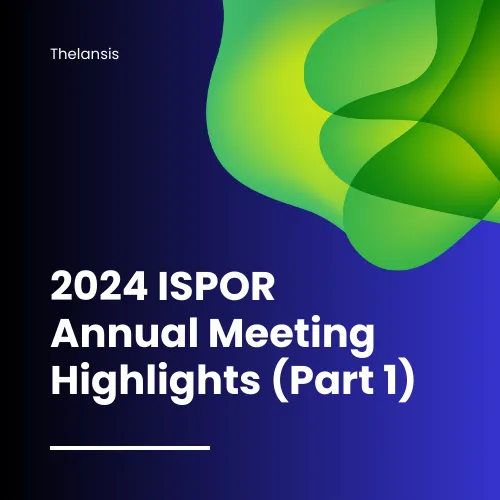
May 09 2024
/
2024 ISPOR Annual Meeting Highlights – Anticipated impact of Inflation Reduction Act (Part 1)
[vc_row css=”.vc_custom_1715260973671{margin-top: -30px !important;}”][vc_column][vc_custom_heading text=”2024 ISPOR Annual Meeting Highlights – Anticipated impact of Inflation Reduction Act (Part 1)” font_container=”tag:h2|text_align:left|line_height:1.35″ use_theme_fonts=”yes” css_animation=”fadeInUp”][/vc_column][/vc_row][vc_row css_animation=”fadeIn”][vc_column][vc_column_text]
The Inflation Reduction Act (IRA) aims to reduce Federal government spending for Medicare Part D and Part B-covered drugs by allowing the government to negotiate drug prices with drug marketers, potentially leading to lower prescription drug costs for Medicare-covered patients. For the 10 high-cost drugs with highest government spending on Medicare Part D, negotiations kicked off in early 2024 and the new prices will be effective in 2026.
Multiple research posters were presented at the 2024 ISPOR Annual Meet, Atlanta, USA, in May 2024, to elucidate the anticipated impact of IRA on payers and the pharmaceutical industry after the implementation of the Medicare Price Negotiation in years starting from 2026.
[/vc_column_text][/vc_column][/vc_row][vc_row css_animation=”appear”][vc_column][vc_column_text]
Table: List of key posters presented on the anticipated impact of IRA
| Title | Author(s) |
| Will the IRA’s Negotiation Timelines Delay Access to Drugs for Orphan Indications? | Masia N. |
| Strategic Implications for Biopharmaceuticals: Navigating the Medicare Price Negotiation Provisions of the Inflation Reduction Act | Briggs S, et al. |
| Evaluating Healthcare Costs and Demographics of Medicare Part D Beneficiaries Impacted by First Top 10 Drugs Selected for Price Negotiations Under the Inflation Reduction Act (IRA) | Varghese I, et al. |
| Impact of the Inflation Reduction Act on Payer Utilization Management – Insights from a Quantitative Survey | Saxena V, et al. |
| Inflation Reduction Act: How Will the First 10 Drugs Selected for Medicare Price Negotiations Impact US Commercial Payers? | Sidhu C, et al. |
| Assessing Cost-Savings From the Inflation Reduction Act in Louisiana Medicare Beneficiaries Due to Diabetes Medications | Winberg D, et al. |
| An Analysis of Stakeholders’ Contribution to High-WAC and Low-WAC Adalimumab Products in 2025 Under the Inflation Reduction Act in the United States | Yoo H, et al. |
[/vc_column_text][/vc_column][/vc_row][vc_row css_animation=”fadeIn”][vc_column][vc_column_text]
Key Findings:
The IRA could lead to substantial changes in the pharmaceutical industry in terms of the investment priorities, launch strategies, lifecycle management strategy, and robust data requirements on clinical and health-economic outcomes.
At present, one of the common drug development strategies is to focus on the subset of patient populations with high unmet needs (that may be orphans), followed by targeting broader populations after initial success in the smaller subpopulation. Given that IRA has a provision for reduction in the drug prices for small molecules starting from the 9th year from the drug’s first launch, an interesting research presented by Masia N shows that pharmaceutical firms would prioritize developing drugs for a broad indication in order to maximize their revenues in the initial years of launch and thereby, the drug development for orphan indications will likely be deprioritized. The same concern was highlighted in the poster presented by Briggs S, et al. The authors further highlighted that developers may plan to develop the drug for multiple relevant indications simultaneously instead of in a sequential pattern to maximize revenues before the applicability of price negotiations.
According to the research by Masia N for “orphan-first” launches that received approval for the broader indication(s) later, a substantial proportion of sales occurred well past 9 years of the first approval. Overall, IRA is expected to provide clarity on any incentives for post-approval R&D in order to circumvent pharmaceutical firms from deprioritizing development for orphan indications.
For biopharmaceuticals, drug developers would prefer investment in the areas where safeguards exist from IRA-imposed risks (e.g., vaccines, gene therapies). Another such area would be therapy indications in pediatrics or adolescents, as mentioned by Briggs S, et al. Drug targeting indications with a large population size but with a lower per-patient cost would be of great focus. Because of the temporary protection provision (until 2029) for “small biotech,” big pharmas would prefer co-commercialization / partnership models rather than the acquisition of small biotechs.
For price negotiations, robust evidence/data on clinical value, HEOR, and comparative analysis versus standard of care would be useful, and thereby, pharmaceutical companies would focus on these data generation to a greater extent than at present. Demonstrating clinical value in patient subgroups (e.g., elderly, pediatrics) would also play an important role in price negotiations.
Conclusion: Overall, drug developers will need to realign their strategies (e.g., target patients, pipeline development, launch sequence, investment decisions) based on the IRA provisions, such as potential exemptions, the therapeutic areas most likely to be impacted, and factors that would impact price negotiations.
References:
- ISPOR Annual Meeting, USA, May 5-8, 2024.
- Masia N. Will the IRA’s Negotiation Timelines Delay Access to Drugs for Orphan Indications? Value in Health, Volume 27, Issue 6, S1 (June 2024).
- Briggs S, et al. Strategic Implications for Biopharmaceuticals: Navigating the Medicare Price Negotiation Provisions of the Inflation Reduction Act. Value in Health, Volume 27, Issue 6, S1 (June 2024).
[/vc_column_text][/vc_column][/vc_row][vc_row css_animation=”fadeIn” css=”.vc_custom_1715261341755{margin-top: 20px !important;}”][vc_column][vc_column_text]
Thelansis’ PayerPro360: Empowering Pharma/Biotech with Robust Payer Insights. PayerPro360 is an innovative and user-friendly AI-based platform designed and developed by Thelansis Knowledge Partners to revolutionize Payer Research.
For customized payer research, please ask for a demo of our innovative research tool: PayerPro360 (https://thelansis.com/payerpro360/). Below highlighted are the features of PayerPro360:
[/vc_column_text][/vc_column][/vc_row][vc_row css=”.vc_custom_1715261349236{margin-top: 20px !important;}”][vc_column][vc_single_image image=”14616″ img_size=”large” alignment=”center” css_animation=”appear”][/vc_column][/vc_row]

